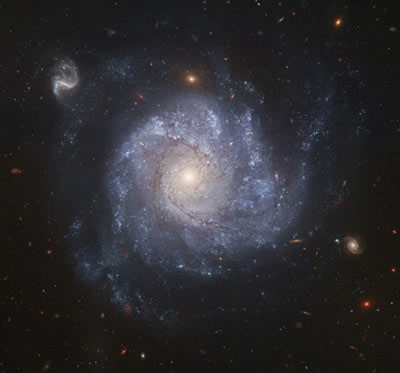Sometimes NASA gets it right, of course. Despite the foofooraw about political censorship inside of NASA, very fine work gets done by the agency.
For example, that picture is from Hubble, launched by NASA in 1990 (click it for a bigger version, or here for a ginormous version). The galaxy is NGC 1309, a gorgeous face-on spiral roughly 100 million light years away. Oddly enough, astronomers consider that nearby.
That’s important, actually. There’s some real science behind this pretty face! About three years ago, the light from an exploding star in that galaxy reached our telescopes here on Earth. It was designated SN2002fk, meaning it’s a supernova, it blew up in 2002, and it was the 162nd one to be seen that year – they are labeled alphabetically, so the first was 2002a, the second 2002b, the 27th 2002aa, etc. But more than that, it’s a special type of supernova… the kind many astronomers like best.
It’s called a Type Ia, which means it was a binary star, a normal star like the Sun orbiting (or orbited by, depending on your taste) a white dwarf, a compact, very dense cinder of a star that was once like the Sun. It has intense gravity, which can draw matter off the other star which piles up on the surface of the dwarf. When the dwarf reaches a certain mass, suddenly the gravity is strong enough that the very matter which makes up the star can fuse catastrophically, turning the star into a gigantic hydrogen bomb. It’s a bit more powerful than your standard H-bomb, though: about 25 octillion (25,000,000,000,000,000,000,000,000,000) times a 1 megaton bomb.
The beauty of this type of supernova is that each one blows up with just about the same energy, meaning that any time you see one, in principle you can determine its distance! You just measure how bright it looks through the telescope and compare it to how bright you know it really is, and the distance just falls out of the equation. Presto!
Well, it’s not that easy, of course. We haven’t studied enough Type Ias to get a really good calibration on them. So when one appears in a nearby galaxy, like, say, NGC 1309, astronomers pounce on it. It’s bright, so they can get good data on it, and dissect it as much as possible.
Why? Well, the explosions are so bright they can be seen from large distances, even billions of light years. If you see one blow up, and you can figure out its distance, you can use them to measure things like how fast the Universe is expanding (it’s a bit like measuring distant car headlights at night to better understand the road you’re on). In fact, these are the very kind of supernovae used to figure out the universal expansion is accelerating! Astronomers are very keen to understand this better; it’s not exaggerating to say it’s one of the biggest problems in cosmology right now.
So when you look at that picture and admire its sheer beauty, let the thought rumble around in your mind that one of those tiny dots in the image is actually light from one of the fiercest events in the Universe, and may shine a light – literally – on the fate of the cosmos in which we live.’
